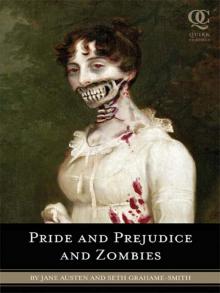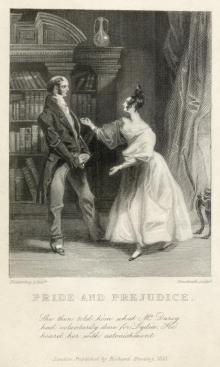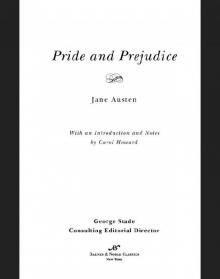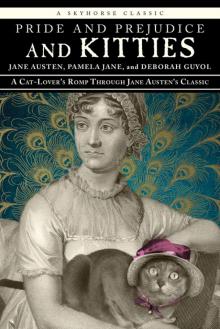- Home
- Jane Austen
The Annotated Sense and Sensibility Page 2
The Annotated Sense and Sensibility Read online
Page 2
Even more influential in spreading the cult of sensibility were the novelists of the time. It was during the eighteenth century that the novel emerged as a major literary genre, one that attracted both a large readership and a host of writers to cater to that audience. The novel, thanks to the opportunity it provided for intensive exploration of inner emotion, proved to be an ideal vehicle for advocates of sensibility. Samuel Richardson, the most popular of all eighteenth-century novelists, one who more than anyone made the genre influential and respectable and who exercised a critical influence on Jane Austen, created potent representations of sensibility in his work. His first two novels, Pamela (1740) and Clarissa (1748), both concern highly virtuous and beautiful young women who are subject to a series of cruel trials, principally involving powerful men who wish to rob them of their virginity. Both heroines are creatures of acute feeling and sensibility, and the novels, especially Clarissa, devote considerable space to the elaborate exposition of their feelings, often at the expense of plot movement. Both novels also show the heroines’ purity and virtue exercising a powerful influence on the feelings of others, and inspiring them to better conduct. Richardson’s last novel, Sir Charles Grandison (1754), concerns a man who is a model of sensitivity and tenderness; a central purpose of the book was to show that such qualities, even if particularly associated with women, were compatible with manliness.
The two other leading novelists of the mid-eighteenth century, Henry Fielding and Laurence Sterne, also express approval of important elements of sensibility in their works. Fielding satirizes some parts of Richardson and rejects an ideal of extreme tenderness and delicacy, especially for men. Yet both his heroes and heroines are creatures of strong emotion, whose good actions spring more from instinctive generosity than from reason. Sterne goes even farther in this direction, for his most famous novel, Tristram Shandy (1760–67), presents a world of disorder and incoherence in which rational forms of understanding, planning, and communication are ultimately impossible, and the characters’ benevolent, though frequently illogical, feelings provide the only possible source of happiness, good actions, and true connection with their fellow creatures. His other novel, A Sentimental Journey (1768), helped popularize the term “sentimental,” which was recently coined and linked to sensibility. That novel is an almost plotless chronicle of the hero’s intense emotional reactions to a variety of mundane experiences, in which the quality of feeling is elevated above every other consideration.
The later decades of the eighteenth century witnessed many more novels of sensibility. A succession of books appeared with heroes and heroines who displayed the most acute feelings toward the sundry events of life, even the most trivial, and who were designed to evoke similar feelings in the reader. Two of the most popular novels of the 1770s were Henry Mackenzie’s The Man of Feeling and Goethe’s Sorrows of Young Werther (sensibility was admired throughout Europe, most notably in France, whose sentimental fiction influenced many English writers). The title characters of both these novels are men of such extreme sensitivity that they are unable to cope with the frequently cruel and harsh world around them, and ultimately die from a broken heart. Both men are presented sympathetically, and the extremity of their misfortunes provoked copious tears from their many readers, tears being considered by that point a great mark of virtue. One woman later remembered reading The Man of Feeling when she was fourteen and dreading that she would not cry sufficiently “to gain the credit of proper sensibility.”2 Her reaction is not unique: “contemporary letters and memoirs, especially those of women, show a society very ready to weep and tremble, and to take credit for doing so.”3
By the end of the eighteenth century there was also an increasing reaction against the cult of sensibility. Its extravagant celebrations of the most extreme emotions inevitably provoked dissent, even among those who approved of sensibility in moderation. Both Mackenzie and Goethe, especially the latter, expressed later reservations about what their popular novels had extolled. Others articulated more complete critiques. Samuel Johnson, one of the leading writers of the time and another important influence on Jane Austen, rejected basing morality on feeling on the grounds of human fallibility and the inevitable unreliability of emotion. His objection stemmed partly from traditional Christian doctrines. Although many advocates of sensibility, most notably Samuel Richardson, were devout Christians whose writings contained strong religious elements, central aspects of sensibility clashed with fundamental tenets of orthodox Christianity. Traditional Christian doctrine emphasized the inherent sinfulness of humanity, the importance of controlling our often sinful passions, and the need to rely on divine guidance rather than personal sentiments in determining right from wrong.
“The Triumph of Sentiment”: a satire on the vogue for sentimental literature; here a butcher weeps over The Sorrows of Werther, even as his wife disembowels a carcass in the background.
[From Joseph Grego, Rowlandson the Caricaturist (London, 1880), Vol. I, p. 210]
[List of Illustrations]
During the 1780s, and even more so the 1790s, a series of novels appeared explicitly denouncing sensibility. In them one or more characters of ardent emotion, often inspired by ideals of sensibility, are led by these ideals or their own feelings into foolish, self-destructive, or even immoral behavior. Sometimes the character ultimately sees the error of his or her ways and reforms, sometimes not. One of these books, Jane West’s A Gossip’s Story, probably exercised some influence on Sense and Sensibility. It concerns two sisters, Louisa and Marianne Dudley, who represent, respectively, rational sense and excessive sensibility. Marianne Dudley, like Austen’s Marianne Dashwood, is led by that sensibility to bestow her love imprudently, and in her case there is no final redemption; meanwhile, her sensible sister avoids trouble and finds happiness.4
Other novels take a mixed position, while still showing the strong influence of the issue. Ann Radcliffe, whose gothic horror novels were bestsellers of the 1790s (and were satirized in Northanger Abbey), strives hard to arouse emotions in the reader, including those of sentimental pity, and devotes considerable space to fulsome evocations of the beauties of nature similar to those found in writers who advocate sensibility. But she also delivers a consistent moral message about the need for rational self-control in her heroines as they confront various terrors and trials. The political climate of the 1790s, marked by the fierce reactions to the French Revolution, also shaped debate on these issues. Because novels of sensibility gave primacy to individual standards over social mores, many conservative writers in this period castigated them for allegedly encouraging radicalism. There was no strict political correlation, however; for the leading conservative book of the decade, Edmund Burke’s Reflections on the Revolution in France, contains strong appeals to sentimental feelings, while many radical writers openly eschewed the idea of sensibility.
This cultural context suggests why Jane Austen would have been stirred in the latter part of the 1790s to begin a novel exploring sensibility. Marianne Dashwood’s feelings and ideas exemplify central principles espoused by its advocates, while the miseries she inflicts on herself and others echo those evoked or portrayed by its critics. The years after 1800, when Jane Austen was revising the novel, saw explicit discussion of sensibility fade. But the underlying issues remained, for most of the main elements of the doctrine were replicated in Romanticism, which emerged during these years as the dominant force in much of the art, literature, and thought of the Western world. The final version of the novel reveals an awareness of these new trends by mentioning Sir Walter Scott, whose Romantic narrative poems were the greatest sellers of the age, as one of Marianne’s favorite writers, and by satirizing the Romantic taste for the cottage, a new fad among the wealthy in England in the years after 1800. While it is not certain whether Austen would have set out to write a novel criticizing sensibility during this later period, she undoubtedly sensed, with justification, that the issues it raised and the points it made remained highly pertinent.
Jane Austen’s interest in exploring the value of sensibility shapes the entire plot of the novel, as well as many of its other features. Most strikingly, it results in the only Austen novel with two heroines. In every other novel one person is the focus; here, though everything is told from Elinor’s perspective, Marianne is consistently present and the sisters’ respective stories are given equal weight. The novel follows a pattern of regularly switching back and forth, after approximately equal intervals, between each sister. It also provides parallel developments within the two story lines, by having each sister face the loss of the man she loves. Thus the very different reactions of the two demonstrate the relative strengths of sense and sensibility.
In making this comparison the author portrays Elinor’s sense more sympathetically than Marianne’s sensibility. The extent of the author’s partiality is a matter of controversy. Many critics argue that the novel shows both heroines as excessive in their particular quality, and that just as Marianne must learn greater sense, Elinor must develop greater sensibility. Yet Elinor is never shown to be deficient in feeling. The paragraph in the opening chapter makes this clear: “She had an excellent heart;—her disposition was affectionate, and her feelings were strong, but she knew how to govern them.” It is this governance of one’s feelings, not their absence, that marks the sense represented by Elinor. Her strong feelings appear at various points in the novel, when she learns of Edward’s prior engagement, witnesses Marianne’s rejection by Willoughby, attends Marianne in her illness, or learns of Edward’s unexpected release from Lucy. But, here and elsewhere, her strong self-control keeps her feelings from ever being as manifest as Marianne’s. Nor does anything in the novel call her sense into serious question. The errors she makes are few and minor, and do not result from any particular defect of sense. Moreover, while Marianne is forced eventually to acknowledge her grave errors and resolve on a completely different course, Elinor is able, with full justification, to dispense the same basic wisdom at the end as she has been laying down from the beginning. She in fact embodies the basic ideal Jane Austen develops in all her novels, one in which genuine and acute feeling, a quality the author never disparages, is balanced and restrained by the equally important principles of self-control, reason, respect for social rules, and willingness to put others before oneself—all of which Marianne must learn.
In extolling Elinor at the expense of Marianne the novel does not condemn the latter’s basic character. It shows her many attractive qualities, treats her sympathetically throughout, and eventually arranges a fate for her that is as happy as her sister’s. In her love of those around her, her sense of right and wrong, her generosity, intelligence, education, eloquence, and artistic talents and tastes, Marianne is comparable to Elinor. The most significant difference, from which other differences flow, is in their respective adherence to the principles of sense or sensibility. As in a scientific experiment, Jane Austen has made her two subjects of study as similar as possible, in their attributes, their backgrounds, and their romantic experiences, in order to isolate a single variable, in this case their contrasting principles. Thus, when one acts so rightly and the other so wrongly, the only explanation lies in that variable, and the proof of the superiority of one principle is complete—insofar as such a thing is possible in a work of fiction. Marianne’s good qualities also give her failures a particular poignancy, by showing how someone with such deep love for her mother and sister can end up inflicting great misery on them, or how someone of such high intelligence can descend to great folly.
Moreover, both Elinor and Marianne are far more than simple representatives of intellectual positions. The didactic imperative of the novel is balanced by the imperative, always central for Jane Austen, of creating fully believable and complex characters. Elinor and Marianne are, like all Austen characters, especially the main ones, realistic and vivid individuals. It is because of this that the reader cares about them so much and that the novel has continued to attract so many readers, long after the specific controversies surrounding sensibility have faded and other works addressing that controversy, such as West’s A Gossip’s Story, have sunk into obscurity.
These dual imperatives of the author are also manifest in another feature of the novel, its general tone, which is darker and more acerbic than that of any other Austen novels. This reflects the seriousness of its subject. The tone also allows the author to test the heroines’ respective principles by plunging them into a variety of difficult ordeals, and to explore darker aspects of human behavior and experiences more fully than she does elsewhere.
This graver tone is established at the beginning of the novel. The plot is set in motion by two deaths, that of the heroines’ great-uncle and their beloved father, and two terrible acts of injustice toward the heroines: their great-uncle’s refusal to repay their assiduous attentions to him with a decent inheritance and their wealthy brother’s refusal to honor his promise to his father to assist them. This is soon followed by the heroines’ displacement from their grand home and familiar neighborhood to a much less spacious and less comfortable cottage, located far away. No other Austen heroine lives in such straitened circumstances; even the other two who have little or no fortune, Elizabeth Bennet and Fanny Price, inhabit fine houses with a full complement of servants and luxuries.
The heroines also confront a uniquely unpleasant set of characters over the course of the story. Like all Austen novels, Sense and Sensibility offers an array of supporting characters who are in some respects foolish or vulgar or absurd—Sir John and Lady Middleton, Mr. and Mrs. Palmer, Mrs. Jennings, Anne Steele. They provide comic relief to the reader while causing mild annoyance to the heroines. But to this Austen has added another half dozen characters, most of whom play an important role in the plot, who are distinctly nasty and selfish—Willoughby, Mrs. Ferrars, John Dashwood, Fanny Dashwood, Robert Ferrars, and Lucy Steele. The last three exhibit no redeeming characteristics whatsoever. All this means that the heroines spend much of the time being forced to witness despicable specimens of humanity and subjected to various forms of mistreatment. Nor does the reader even have the relief of seeing justice done to those who are selfish and cruel, for by the novel’s end all of the characters have prospered. Sense and Sensibility is the only novel in which Jane Austen does not take care to mete out general just deserts, which arguably reflects a greater realism, for in the other novels Austen can become a little heavy-handed in allotting justice to all.
The heroines’ romantic trials also surpass those found in the other novels. Marianne suffers from encountering a figure who appears in every Austen novel except Northanger Abbey—the charming man who woos the heroine before proving untrustworthy in some respect. Willoughby, however, stands out as the most attractive of all these charmers, with his combination of physical beauty, intelligence, musical talents, and great energy. He also woos the heroine more ardently than any other, with the exception of Henry Crawford in Mansfield Park. His desirability and Marianne’s own incautious enthusiasm make her, unlike all the other heroines in question, fall deeply in love. At the same time, the disappointment he inflicts is far worse than his analogues. He does not simply drift away or turn out to be engaged elsewhere. He abandons Marianne—abruptly, without explanation, and just after expressing his most fervent devotion—and when she eventually locates him he responds with complete coldness and a letter of egregious callousness. Finally, the revelation of his past wickedness forces Marianne to contemplate that she just missed a terrible fate while also calling into grave question her earlier judgment.
As for Elinor, her trials have a couple of analogues, for Fanny Price and Anne Elliot also must witness the attachment of the man they love to another woman. Elinor, however, is the only one to suffer from the dishonorable usage of being wooed, albeit hesitantly, while the man is engaged to another. In contrast, Fanny’s love always treats her kindly; Anne suffers from her love’s cold aloofness, but she knows that this is the natural product of her own
earlier rejection of him. Furthermore, Fanny’s and Anne’s female rivals have some good qualities, whereas Elinor’s is one of the most odious characters ever created by Jane Austen. This means that in addition to her own loss, Elinor must anticipate great future misery for her beloved. She is also subject to cruel persecutions by her rival, from being trapped into a painful promise of secrecy to being forced to listen repeatedly to the other woman’s gloating and snide remarks—all at a time when Elinor is being mistreated by Edward’s relatives due to their misperception of the real situation.
The combined effect of these ordeals is to place the heroines’ virtues and flaws in sharper relief. Marianne’s sensibility leads her into even greater misery and imprudence than would have occurred under less difficult circumstances, while Elinor’s ability to maintain her composure and act correctly shines even more brightly. In fact, Elinor is such a model of good thinking and behavior under duress, despite being only nineteen, that she borders on the implausible. In her case the author’s didactic purpose overwhelms her realism on occasion. Yet more often the deep feelings that Elinor also possesses, and that she must struggle continually with in order to maintain her good sense, make her believable, while such feelings and struggles earn her the full love and sympathy of the reader.
Marianne is also able to win such sympathy. Her numerous mistakes and follies threaten to turn the reader against her. But the many good qualities she also displays, including a good share of natural, even if misdirected, sense, make her someone whose fate seems of vital importance. Moreover, she is only seventeen, as well as lacking experience and a sensible parent to provide guidance. Thus while her faults stem from bad doctrine, her fervent adherence to that doctrine and refusal to acknowledge its deficiencies is at least partly the product of her youth and circumstances. This encourages the reader’s forgiveness, while also making it plausible that, having been forced to perceive her errors while still young, she will amend her ways and be capable of leading an excellent life. Thus her story, even with its dark sides, can still ultimately fit into the author’s fundamentally comic vision of life.

 Sense and Sensibility
Sense and Sensibility Persuasion
Persuasion Mansfield Park
Mansfield Park Northanger Abbey
Northanger Abbey Pride and Prejudice and Zombies
Pride and Prejudice and Zombies Pride and Prejudice
Pride and Prejudice Emma
Emma Persuasion (Dover Thrift Editions)
Persuasion (Dover Thrift Editions) Lady Susan
Lady Susan Northanger Abbey (Barnes & Noble Classics)
Northanger Abbey (Barnes & Noble Classics) Lady Susan, the Watsons, Sanditon
Lady Susan, the Watsons, Sanditon Darcy Swipes Left
Darcy Swipes Left Persuasion: Jane Austen (The Complete Works)
Persuasion: Jane Austen (The Complete Works) Mansfield Park (Barnes & Noble Classics Series)
Mansfield Park (Barnes & Noble Classics Series) Sense and Sensibility (Barnes & Noble Classics Series)
Sense and Sensibility (Barnes & Noble Classics Series) The Annotated Sense and Sensibility
The Annotated Sense and Sensibility Pride and Prejudice (Clandestine Classics)
Pride and Prejudice (Clandestine Classics) Persuasion (AmazonClassics Edition)
Persuasion (AmazonClassics Edition) Persuasion (Barnes & Noble Classics Series)
Persuasion (Barnes & Noble Classics Series) Complete Works of Jane Austen
Complete Works of Jane Austen The Watsons and Emma Watson
The Watsons and Emma Watson Northanger Abbey and Angels and Dragons
Northanger Abbey and Angels and Dragons Love and Friendship and Other Early Works
Love and Friendship and Other Early Works Emma (Barnes & Noble Classics Series)
Emma (Barnes & Noble Classics Series) Sanditon
Sanditon Pride and Prejudice (Barnes & Noble Classics Series)
Pride and Prejudice (Barnes & Noble Classics Series) Pride and Prejudice and Kitties
Pride and Prejudice and Kitties The Annotated Northanger Abbey
The Annotated Northanger Abbey Oxford World’s Classics
Oxford World’s Classics Northanger Abbey (Barnes & Noble Classics Series)
Northanger Abbey (Barnes & Noble Classics Series) The Annotated Persuasion
The Annotated Persuasion Emma (AmazonClassics Edition)
Emma (AmazonClassics Edition) The Annotated Emma
The Annotated Emma The Annotated Mansfield Park
The Annotated Mansfield Park The Annotated Pride and Prejudice
The Annotated Pride and Prejudice